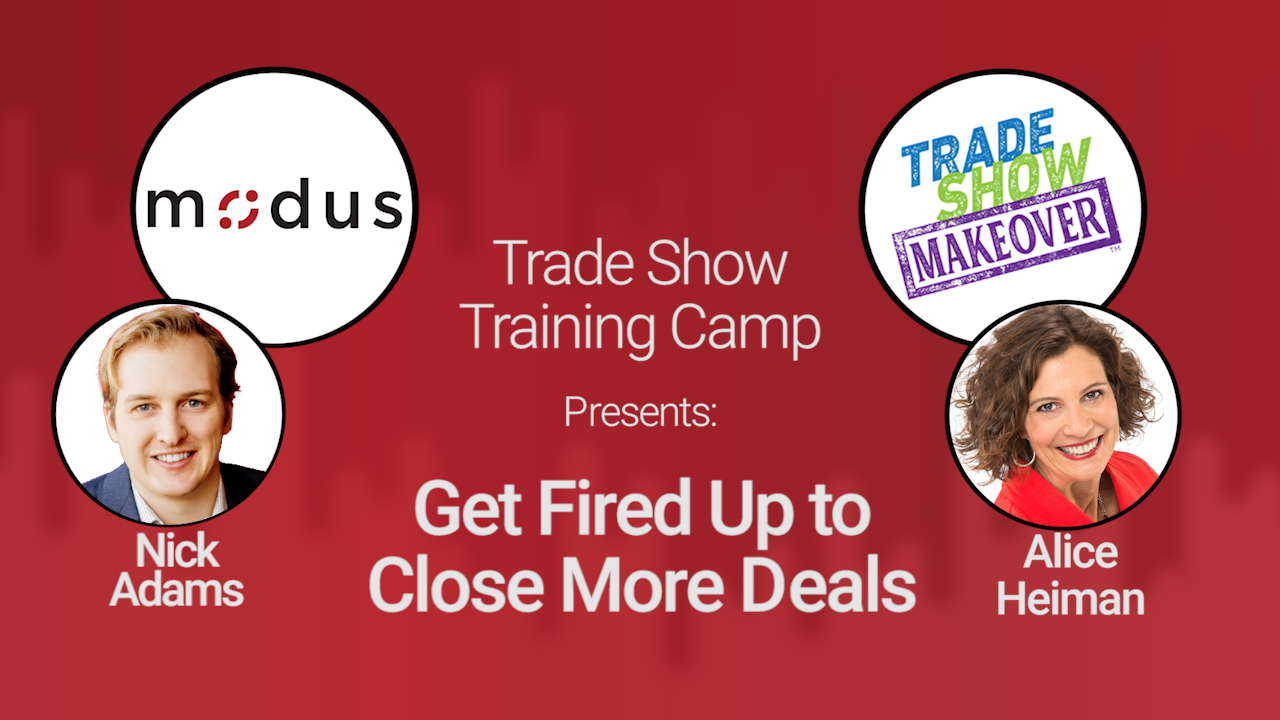
We had a blast this week kicking off our Trade Show Training Camp series, which is designed to teach you valuable techniques that will help you close more deals and generate more revenue this trade show season. The first webinar, "Get Fired Up to Close More Deals," featured myself and TradeShow Makeover Co-Founder, Alice Heiman, who is among the world's leading experts on complex sales and event selling, according to forbes.com.
During the webinar, Alice provides industry-leading strategies on how to capture high-quality leads that will actually turn into sales following a trade show. Check out a snippet of the webinar below and a summary of our Q & A session.

Q: What are some trade show strategies that will help exhibitors drive more revenue?
A: Many companies believe that by just showing up to a show and scanning badges, they are collecting good leads. But honestly, a badge scan is not a lead, and many people that walk by your booth aren’t interested in what you’re selling.
To have a well-thought-out booth strategy for collecting leads, we need to back up a bit and think about our pre-show strategy. We need to get marketing and sales into a room and develop realistic goals that both can agree on for the show. It's crucial that you determine what a “qualified lead," looks like before the show.
At the show, we need to STOP SCANNING EVERY BADGE THAT WALKS THROUGH THE BOOTH. All this does is create a mess for marketing to sift through after the show.
Next, we need to determine other activities to measure success on, and they should be geared toward having great conversations. Things like:
- Pre-booked meetings
- In-booth conversations
- Follow up appointments booked at the show
Q: Whose job is it to generate conversations and traffic to the booth? Marketing or sales?
A: It is a combination of both; it needs to be a joint effort between Marketing and Sales. For example, Marketing can set up a campaign through email or snail mail (works great these days) in combination with social media. On social, they can use the event’s hashtag and prepare tweets/posts ahead of time to engage with those event tags, and the people they end up engaging with online can be passed to sales to engage them further. Marketing can even teach sales how to interact with those event hashtags on their social channels as well, and that would be a great way to get marketing and sales working together pre-show.
Next, gather a watch list of ideal companies you want to work with and check to see what they are posting about the event online.
Reps should go on LinkedIn and look for the titles of people they want to connect with at the show, interact with prospect's posts, ask for connections on LinkedIn, and engage with the attendees to get to know them before the show. Getting to know your prospects before the show is going to make a significant impact on your results.
Q: Are exhibitors afraid to focus on Quality over Quantity when it comes to leads? (may make their shows look less busy and less effective initially because of lower lead counts)
A: When it comes to Quality versus Quantity, it is all about Quality lead data. One thousand junk leads aren’t going to pay the bills, and it will be nearly impossible to find real opportunities if you don’t capture the right information.
It starts with training reps to ask the right questions in the booth. Asking the right questions will spur more in-depth conversations for both you and your prospects. Your reps need to go beyond typical BANT information as well. BANT (Budget Authority Needs Timeline) is useful in knowing if you're talking to the right person and whether there's an initial fit or not, but those are very surface level qualifications. Reps need to go deeper and ask questions like:
- What will happen if you don’t find a solution for X? (try to create urgency)
- How would you describe our solution to your colleagues? (how well do they understand your value prop)
- What has prevented you from solving this problem before? (uncover potential roadblocks after the show)
If attendees are giving you their full, undivided attention in the booth, take advantage of that and probe deeper than a form on a website can.
Next, be sure to set up a fast and easy way for your reps to record information while talking to prospects. If you don't have a system in place to capture lead information on the spot, reps will have a hard time remembering the info they've just gathered, and the data will be lost forever. You wouldn't believe how many companies we talk to that still don't have a good process for doing this.
Your reps should not be afraid or intimidated to ask the next person to briefly wait for 15-30 seconds while they enter data into the system. Attendees waiting will appreciate the reps undivided attention and will respect the time it takes to finish recording.
Q: Who should be in the booth to collect this data? SDRs? SMEs? Executives? Booth Babes?!
A: Whom you send to represent you at the show is one of the most critical aspects of trade show planning but is often overlooked. Bottom line--you need to match the people you send, with the people who are attending the show. What I mean by that is, if the show is going to be full of high-level executives, you’re not going to want to fill your booth with SDRs or lower-level salespeople. You are going to want your executive team and senior reps there to have high-level conversations with the executives stopping by your booth. If the show you’re going to is mostly lower-level end-user types, then SDRs or SMEs would be more appropriate.
Q: What are the biggest follow up fails companies make over and over again?
A: Badge scans are not an effective way to measure how engaging your booth was. It would be best if you had a goal for qualified leads, pre-appointments booked, and opportunities created in your pipeline.
Measuring against these objectives is going to align better with the ultimate ROI of your show, versus just focusing on “driving traffic,” you will see your post-event revenue skyrocket.
Next, have a plan and execute a pre-show strategy. 9/10 pre-booked leads will be high-quality leads, so you need to reach out to ideal leads beforehand and report on how you did after the show.
Q: How should exhibitors calculate ROI from their events? Any best practices?
A: Some best practice ROI formula’s that exhibitors can use in their post-show analysis are:
Cost Per QUALIFIED Lead (CPQL) and Close Ratio (CR). CPQL is a metric you can calculate right after the show and is a better way to determine lead costs per show. Qualified leads are better than badge scans as a measure of success because they are going to result in a higher Close Ratio.
Close Ratio (CR) is going to take a little longer to calculate as you’ll need to measure this after your typical deal cycle elapses after an event. However, if you take the time to go back and calculate your CR after implementing a Quality over Quantity approach, you’ll be able to see what your average close rate is on these qualified leads.
So after future shows, you’ll be able to take that CR number and turn it into an Expected Revenue number (Qualified Leads x CR x Average Deal Size) so you can immediately report on what your company should expect to bring in.
After those initial reports, make sure you schedule times to look back after 3, 6, 12, 18 months or after your average deal cycle elapses and look at how Expected Revenue varies from Actual Revenue. If you have a Marketing Automation and/or a CRM system, this will be a lot easier to accomplish due to the advanced tagging features they provide.


